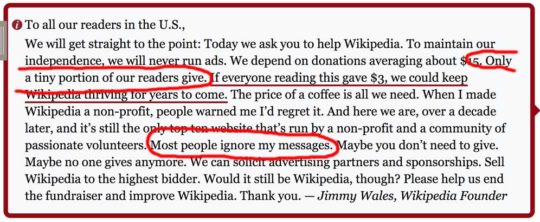Wikipedia Knows What Social Proof Is, But…
If you search Google for “social proof,” the first result – actually a highlighted answer – comes from Wikipedia:
Social proof (also known as informational social influence) is a psychological and social phenomenon where people assume the actions of others in an attempt to reflect correct behavior in a given situation.
In other words, if asked to do something, you will probably try and determine what most other people are doing. That way, you know how to respond yourself in a way that conforms to group norms.
As I pointed out in The Big Mistake Most Non-Profits (and Some Businesses) Make, two years ago Wikipedia made a classic fundraising mistake. Now, they seem to be repeating it with their latest campaign.
Here’s a screen shot of the ad I as shown:

Note the text in the message from founder Jimmy Wales:
“Only a tiny portion of our readers give.”
And, then Wales doubled down with,
“Most people ignore my messages.”
By Wikipedia’s own definition of social proof, these statements are letting readers know that it’s OK not to give. If nearly everyone else ignores these appeals, you can, too.
If you want people to support you, don't complain about how most other people don't help. #Neuromarketing Share on XFixing the Social Proof
The ironic aspect of this is that Wikipedia, or, to be more precise, the Wikimedia Foundation, does have powerful social proof that could be employed to increase donations. They have a very transparent approach to disclosing donations. If I’ve done the math correctly, they received 5,143,492 donations in 2016.
As the Wales letter suggests, five million donations represents a very small portion of total Wikipedia users. And, the actual number of donors is likely even lower due to multiple contributions, monthly donors, etc. But, five million is still a BIG number. So, why not leverage that and test language like:
Last year, we had 5,143,492 donations! Make Wikipedia even better – join an even bigger supporter group this year!
That text would use social proof in a positive way. Another approach I’d test would be a counter that updated every few seconds. It seems that the Wikimedia Foundation has great real-time data, so why not provide an engaging display of year-to-date contributions?

This offers a combination of social proof combined with animation to engage the viewer and show how rapidly the donations are increasing.
Yet another variation to test would be to add a geography element. For example,
Last year 18,272 donations were from Texas!
Depending on the granularity of the available data and the number of donations (the number should be big enough to impress), one could try city (“London”) or country (“France”) variations. Research shows that the more specific the social proof is to the viewer, the more effective it will be.
Social proof is most persuasive when it is specific to the viewer. #influence #Neuromarketing Share on X
If all this social proof has inspired you, here’s where you can support Wikipedia with a donation. (The language on this page is similar but doesn’t offer the same level of negative social proof as the above example. Good job, Jimmy Wales!) And, if you need a bit more social proof, I used that link to make a modest donation. 🙂
What other advice would you give the Wikipedia ask for donations more effectively?
Wikipedia makes a common #fundraising error, here's how to fix it. #nonprofit #Neuromarketing Share on X
